Iveco eDaily van review (2024)
Iveco's eDaily cuts emissions without cutting corners, but it's expensive
PROS
- Proven Iveco Daily chassis and bodies
- Impressive range in urban use
- Versatile, innovative conversion support
- Refined and comfortable
- Should be very long-lived
CONS
- Payload lower than competitors
- AirPro suspension a costly option
- Battery upgrades expensive
- Relatively slow 80kW max charging
- Not cheap compared to rivals
Summary
The Iveco Daily is a long-established and well-regarded vehicle with lots of flexibility and strength, but now it's aiming to take on the best electric vans out there with the new eDaily.
The Iveco eDaily uses the same chassis, bodies and styling as the standard Daily. In fact, the two vans look identical bar a few coloured accents on their trim panels, which is great because all the panels from the standard van will fit the EV if you have a scrape.
This high level of commonality brings other benefits. For example, if you already have a current generation diesel Iveco Daily, it’s theoretically possible to convert it to electric power. That’s great for the planet because you’re taking a diesel van off the road, adding a new zero-emission van and recycling a chassis in one fell swoop.
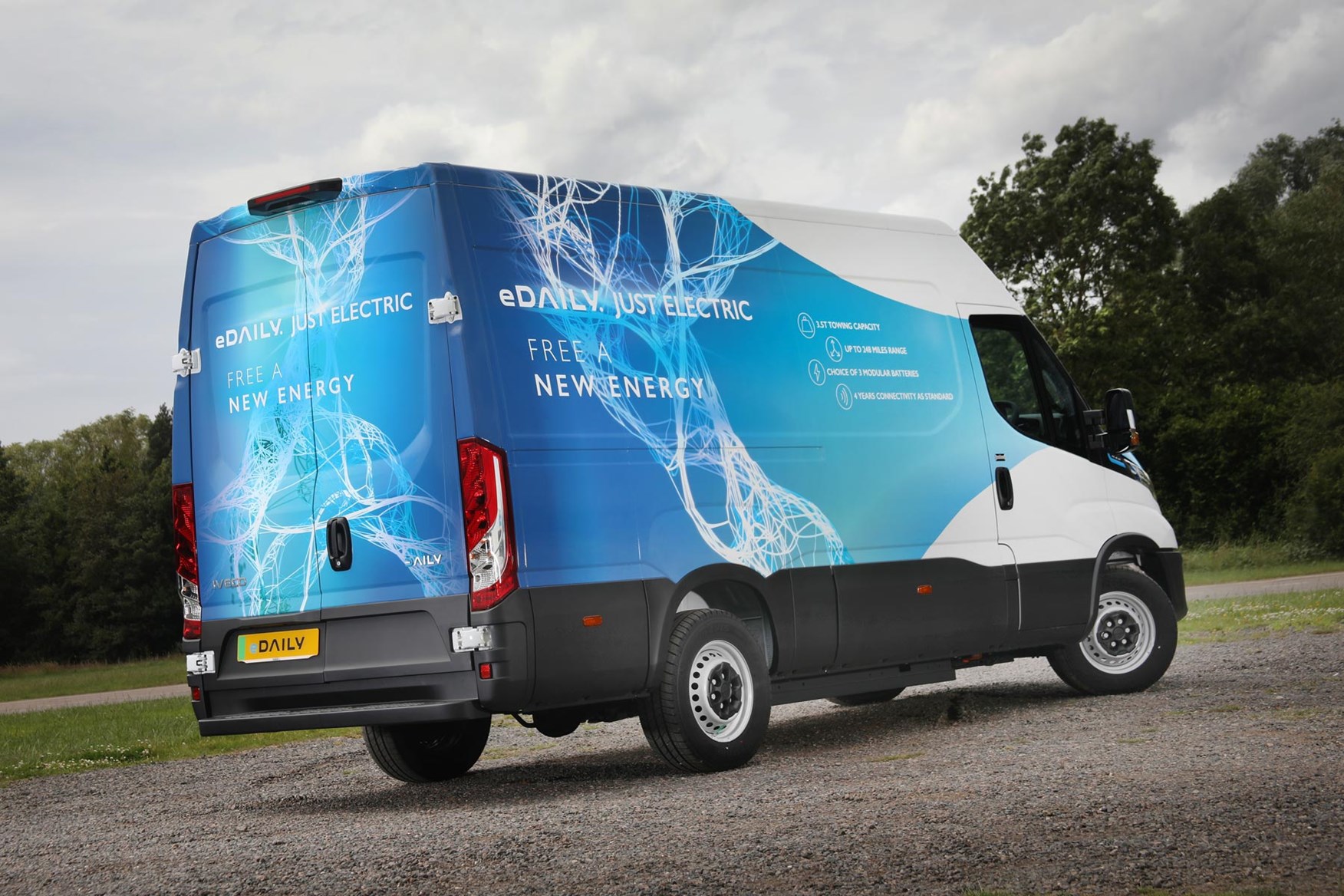
There will be up to 200 variations of the eDaily, reflecting the ‘mission-first’ approach that Iveco now considers to be a key pillar of its brand. Options include chassis cab, crew cab, drop side pickups, freezer trucks and a variety of conversions, from rubbish compactors to crane trucks. What’s more, any auxiliary equipment you bolt onto the van’s chassis can run off the eDaily’s battery pack.
We’re focusing on the panel van here – but the driver experience and fundamentals are the same for chassis cab conversions and tipper bodies. The eDaily van is available in five lengths, three roof heights and several weight classes. So, in addition to vans that suit the 4.2-tonne derogation for electric vans, a 7.2-tonne option is also available for those with heavier-duty needs.
All eDaily models are rear-wheel drive, with a chassis-mounted mid-rear electric motor and a conventional beam axle. The motor is powered by up to three battery packs, each with a capacity of 37kWh. The batteries are the most interesting element of the eDaily, as you can chop and changes the number of cells in the vehicle to suit the changing needs of your business.
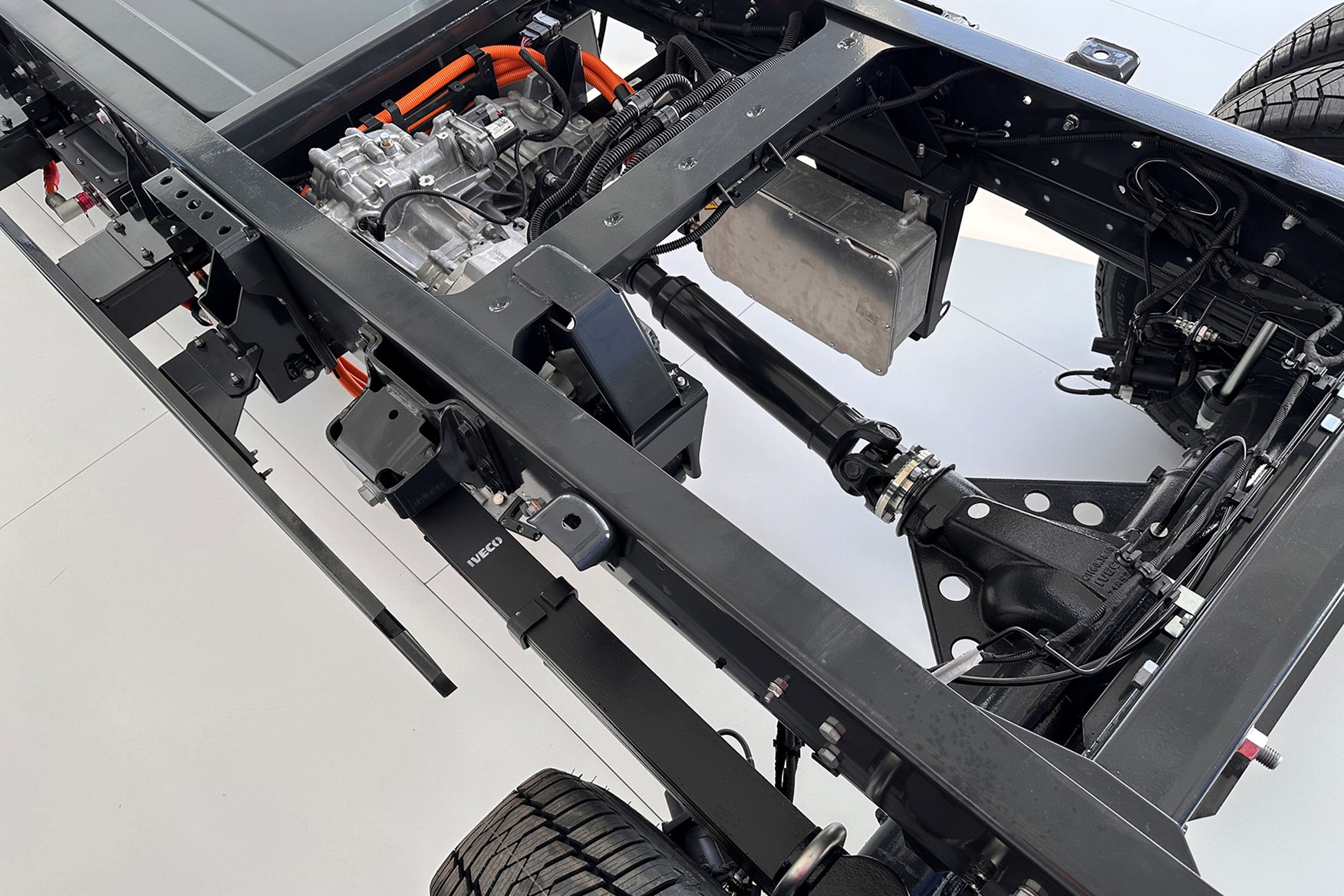
For example, if you buy a one battery eDaily for local deliveries, but then decide to expand your service area, you can add another battery to increase your maximum range. Equally, if you feel like you need more payload and have more range than you are using then you can take a battery out.
Power outputs vary according to the battery configuration you opt for and the drive mode you’re running in, although you get the same motor and electrical tech in every model. Dual and triple battery vans offer up to 190hp and 400Nm in ‘boost’ mode, and 121hp / 220Nm sustained cruising. Output for the single battery option falls to 134hp / 300Nm peak. However, that’s not as bad as it sounds because you can only have this powertrain in the shortest (and lightest) chassis.
Iveco fitted the eDaily’s with some smart electric vehicle features, too. There’s intuitive regeneration including one-pedal driving, connected apps for charging and a user-friendly, appealing dashboard.
Verdict: Is the Iveco eDaily any good?
Because Iveco adopted a modular, evolutionary approach when it designed the eDaily, the van’s chassis, suspension and subsystems are already proven. The standard Daily was a great starting point, too, as it’s arguably the best in class when it’s not seen purely as a competitor for lighter vans.
The eDaily’s electric powertrain is also cutting-edge and clever, and the vehicle is optimised for conversions. Yet for electric van buyers the Ford E-Transit makes more sense. It costs considerably less, and it offers a comparable amount of payload and space.
If you’ve already decided an Iveco Daily is the platform or van for your needs, the eDaily will fit that role just as well for a greener, zero emission option with few compromises. However, if you just want an electric van, the eDaily’s heavy-duty build works against it for payload and economy, as it does with any diesel Daily van.
Read the full review to see how it works, and if it is the right van for you.
Skip to our full verdict on...
- Refined, responsive and intuitive
- AirPro suspension impresses
- Longest range is achieved at urban speeds
The Iveco eDaily feels very familiar before you even switch it on, because it takes much of its design and controls from the diesel Daily. If the electric version behaved differently, that would be confusing for shared fleets. Here’s the thing, though; it doesn’t. It's very like a Daily HiMatic to drive, just quiet.
There are new modes of operation, but the overall experience of driving an eDaily compared with an automatic diesel is intuitive. Performance off the line occasionally has a small hesitation, but it’s responsive enough to accommodate, even intimidate Turin traffic. In Britain, it should prove well up to the challenges of busy streets, frequent drops and slip roads.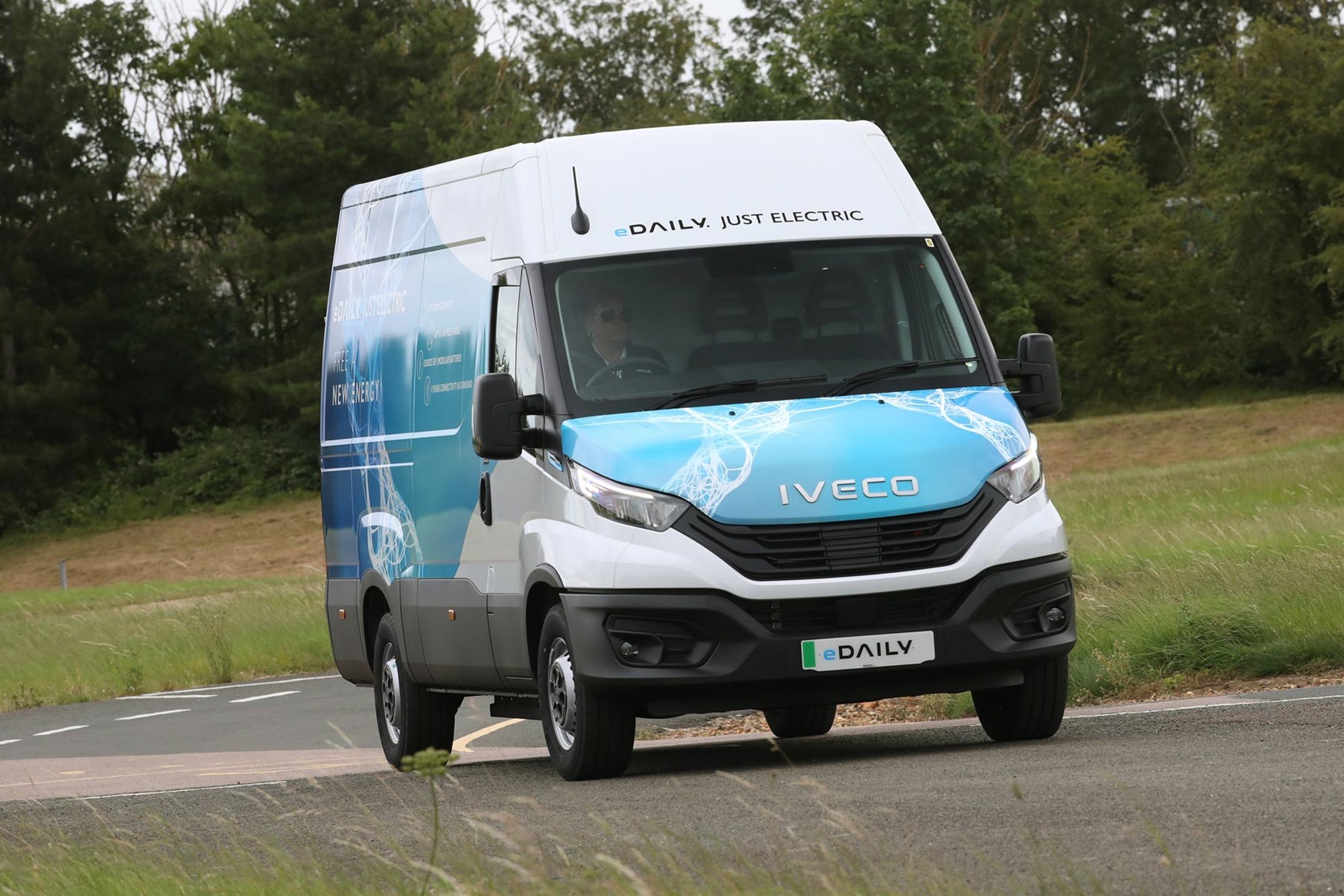
Equipped with AirPro suspension, the van’s handling, comfort and steering reactions are also much improved. But it’s the braking system that really makes its mark. Where many electric vehicles still struggle with modulating regeneration, traditional braking and driver feedback, the Iveco eDaily’s responsive and progressive brake pedal is complemented by three intuitive regenerative modes if you wish to use them.
It’s still a new model and we’ve had limited time behind the wheel, so there may be circumstances where it needs more of a push to respond, or it reacts unexpectedly sharply. But so far, we’ve found it to be very predictable and impressive.
Iveco eDaily regenerative braking
There are three levels of regen available, from coasting to an almost one-pedal mode which, aside from needing a tap of the brakes for busier situations, is excellent in city traffic. The curve for slowing down is gentle, so speed bumps still need a little touch of brake, but the effect is comparable to dropping down a gear or two in an old-school diesel, without the vibration and noise.
Calling it one-pedal driving isn't quite true, though, as it does a good but not complete job at bringing the van to a halt. If you leave it unattended, it will keep creeping forwards. In that sense it isn't quite like the systems on models such as Nissan's passenger cars.
In addition to regeneration, which is selected using the reassuringly familiar gear lever, it’s possible to limit the power output by changing driving mode. As with other electric vans, this allows a longer range without having to concentrate too much on your driving. Controls for drive selection, mode and electric handbrake fall easily to hand in the same group, so it's very natural to use modes and regen 'as a driver,' rather than just set and forget.
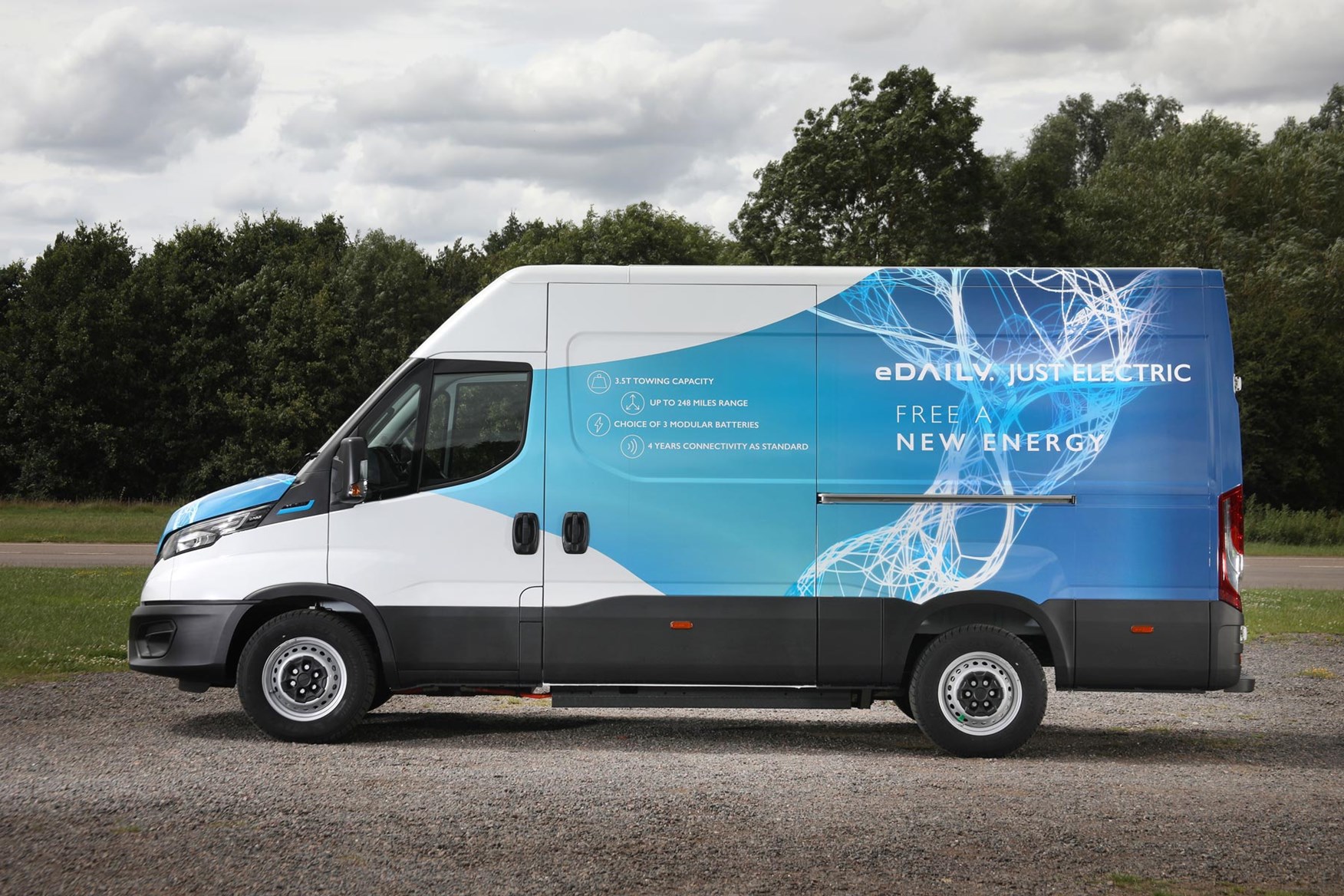
Those three driving modes are Eco, Normal and Power – and there’s a notable difference between the three. As an example, we tested the three going up a 30-degree slope. Eco didn't stop at any point, but only accelerated to 19mph. Power mode reached 27mph and was still accelerating as we crested the hill.
One other thing of note for upward gradients is the lack of hill-hold as standard. Without it, the van didn't pull away until it had rolled back a little, so it is an option worth ticking if you are in a hilly area.
Other excellent features about the driving ability are the hill descent mode, which is a notable addition for a non-4x4 van, and the small turning circle. The latter is as small as 5.5m, which is tiny and a massive bonus in town.
Maximum power is available in limited bursts, something that isn’t unusual for an electric vehicle. However, Iveco has given a gauge to show how much time 'on boost' is available. Burst is also a little unfair – sustained full-power use is available for over two minutes when fully charged, reflecting the potential requirement to tackle hillier terrains while retaining the 3.5-tonne towing capacity.
Iveco eDaily 37kWh battery: less capable than 74kWh or 114kWh
It's not just the range that drops if you choose the 37kWh single battery model. The motor output is limited to 100kW maximum (134hp) instead of 140kW (180hp) – and it isn't rated for towing more than a 750kg unbraked trailer, either.
It's also worth noting that the 37kWh eDaily cannot fast charge on DC, whereas the 74kWh and 114kWh can use 80kW DC charging. However, all specifications run the motor at 90kW / 121hp in normal use, contributing to the van’s competitive energy consumption despite its weight and large frontal area.
- Familiar, but improved, layout
- Solid, well-placed controls
- Can be refined, generally comfortable
Regular Iveco Daily users will know how effectively the van’s cabin has evolved for the needs of full-time drivers, getting better with each generation. Ergonomically sound controls and layout, good weighting and, as of the last refresh, supportive, sculpted seats leave only the generally hard plastics to criticise – and that’s a complaint that can be levelled at all vehicles designed for this sort of hard-working life. The eDaily feels functional yet pleasant to be in. Complementing the very adjustable, comfortable seat, the steering wheel is adjustable for rake and reach.
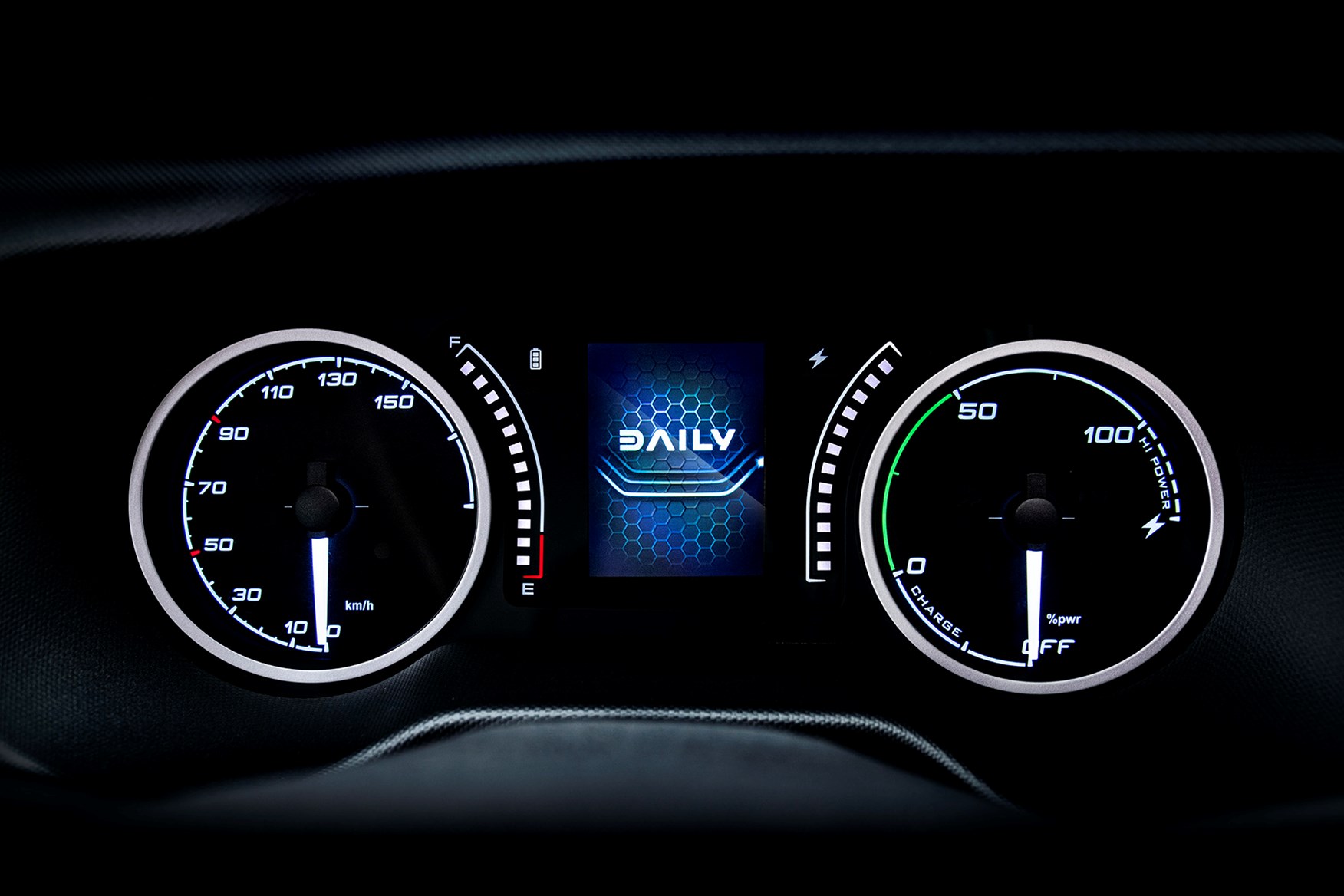
While the eDaily inherits most of its interior from the diesel van, it isn't identical. There's a bespoke hybrid-digital instrument cluster that presents data with the same polish you'd expect in a modern electric car, the infotainment system is clear and easy to use, and the climate controls feel high-tech (for a van). It feels designed to be electric from the start. The drive selector is a similar shape and placement to the HiMatic gearshift, too, so all controls fall easily to hand and feel familiar.
Seat heating is a relatively inexpensive option and you can even get HGV-style floating suspended seats for enhanced comfort, again for a surprisingly low cost. Overall, the eDaily takes an already pleasant working environment, then removes the intrusion of engine noise and gear changes. With the rear-mounted motor, the eDaily’s cab is very serene.
Iveco eDaily comfort with AirPro suspension
Seasoned Iveco drivers know what a steel-sprung Daily sounds and feels like on rough roads, particularly when it’s unladen. This is the first chance we’ve had to experience AirPro suspension, which appears to have replaced the option of pneumatic rear suspension for the eDaily. Combined with the electric motor's smooth progress, the effect is remarkable.
Bigger bumps will thump the body if you drive without consideration, but the small imperfections that rattle and shake a regular Daily are just not worthy of note. They’re absorbed, quietly, even on chassis cabs which have the potential for more flex in the body. Cobbled and unmaintained roads are a revelation, and it seems likely that noise outside the vehicle will also be reduced by the technology.
Handling is good, but ultimately not that different to a conventional setup in terms of outright ability. The ride quality and refinement improvements could be worth the cost if working in a place with particularly poor roads, or operating wildly varying loads between different drivers who may not be familiar with how the van handles. On regular rough routes, AirPro’s effective isolation of vibration could have an impact on the overall longevity of the vehicle as well. It's an expensive option on paper, but as a percentage of the total cost of an Iveco eDaily it is a worthwhile investment.
- Bespoke, highly flexible vehicles are rarely cheap
- But the eDaily’s battery prices are eye-watering on paper
- Residual values may compensate, however
There is an Iveco eDaily to compete with the Ford E-Transit’s headline price, but it won’t suit many people – it’s the smallest, shortest range and not even close in terms of ability. The truth is, you’re not going to go for an eDaily because you fancy an electric van, it’ll be because you need an Iveco Daily, but electric. There is a wide range of pricing, due to the number of versions available. The price range stretches from around £56,000 to over £103,000.
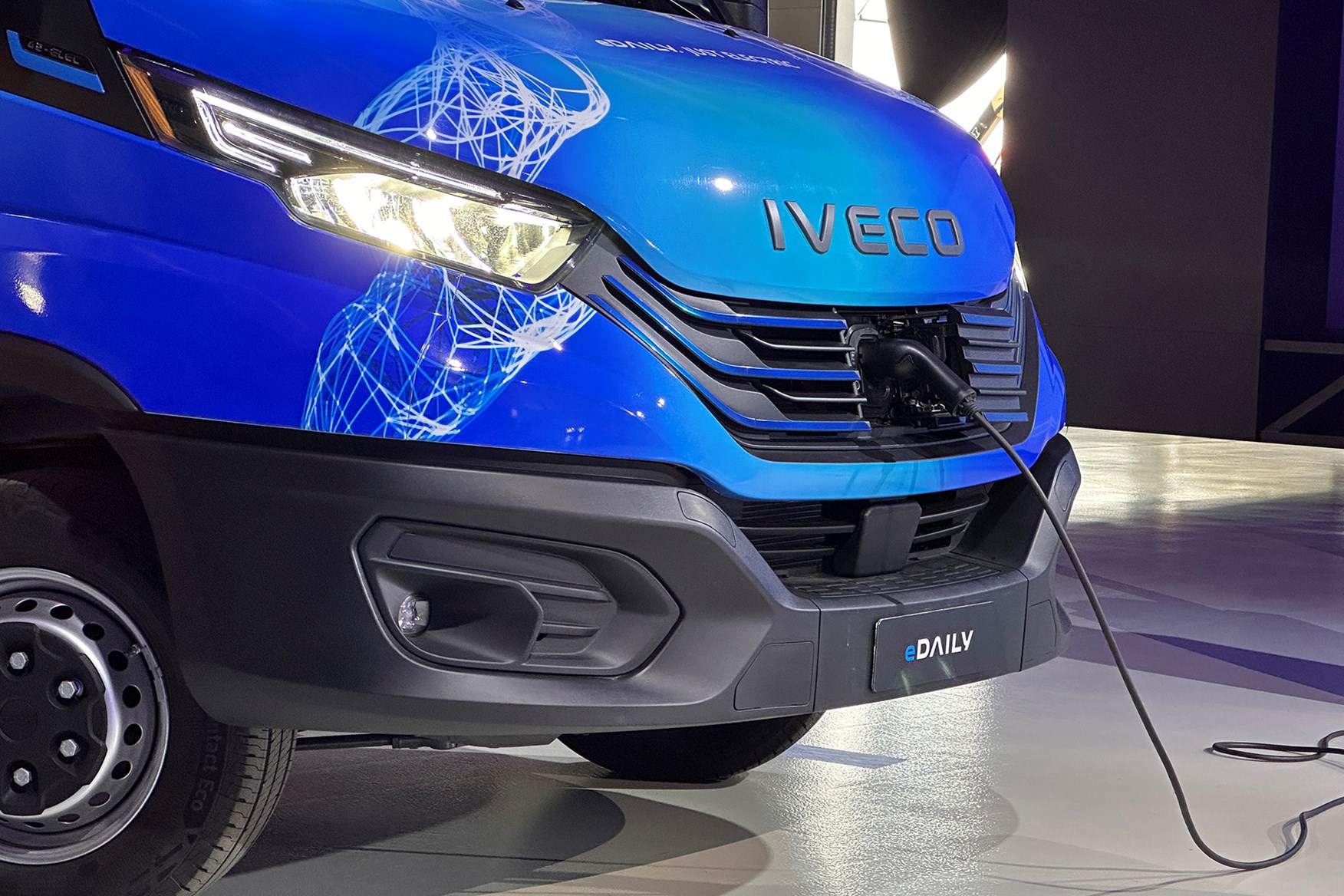
The cost of two battery modules alone, taking the 37kWh model up to the full 114kWh, is comparable to a brand-new conventional diesel van.
Even so, for the technology and capability on offer, combined with the longevity and strength the Daily is already known for, the sums will make sense in the long run for some fleets and operators.
Range, running costs and life expectancy have been pushed to the most efficient levels, with new battery chemistry and heavy-duty engineering prioritised over cost saving. So how much you could save in running costs really depends on your energy infrastructure and any incentives for carbon reduction.
Iveco Gate: pay as you go leasing
Announced at IAA, but yet to be fully revealed in terms of cost and availability, Gate is a subscription service lease for flexible and cost effective fleets. At least, that's the theory; when Iveco announces figures for its Gate subscription service, it may well be the case that the strong resale and long life of electric tech plus the Daily's inherently tough build brings costs down sufficiently, and a pay-as-you-go model becomes practical for lower mileage operators.
Gate is likely to be more than just 'a van for a fee' though, as Iveco is partnering with electric infrastructure providers around the world.
Iveco eDaily range
The official maximum range for an eDaily is 186 miles, which is unsurprisingly for the version with three batteries. However, this is tested with a full payload, and is the 4.25t GVW version, so you might even manage to beat that if you don't spend all your time fully loaded.
This drops to 124 miles for the two-battery model and 68 miles for the single battery version, both on the 4.25t model with full payloads. Iveco also quotes a WLTP figure for the single and two-battery 3.5t model, which was assessed with a half payload. This bumps the range to 74 miles and 146 miles respectively.
Iveco eDaily servicing
The Iveco Daily is already one of the more competitive models for serious fleet users, thanks to its clever telematics integration and 24-hour HGV-style backup. Unsurprisingly, the pure-electric eDaily features the same monitoring technology – but its powertrain requires far less attention, which means it should be cheaper to service (at least in theory). What’s more, the few components that do need regular maintenance are very visible, easily accessible and designed for a long service life.
Reflecting that extended working lifespan, Iveco is already planning second and third owner support. New owners benefit from the Elements 2XL repair and maintenance package for the first three years.
Iveco eDaily warranty
As a ‘mission-first’ vehicle, the finer details of warranty and support may vary according to your fleet deal. However, for van buyers the eDaily has a standard package of three years, up to 100,000 miles, for the overall vehicle – the battery warranty is longer. It also comes with the Iveco Elements 2XL repair and maintenance package, which for £99 covers servicing of driveline and routine maintenance for three years, up to 100,000 miles per year.
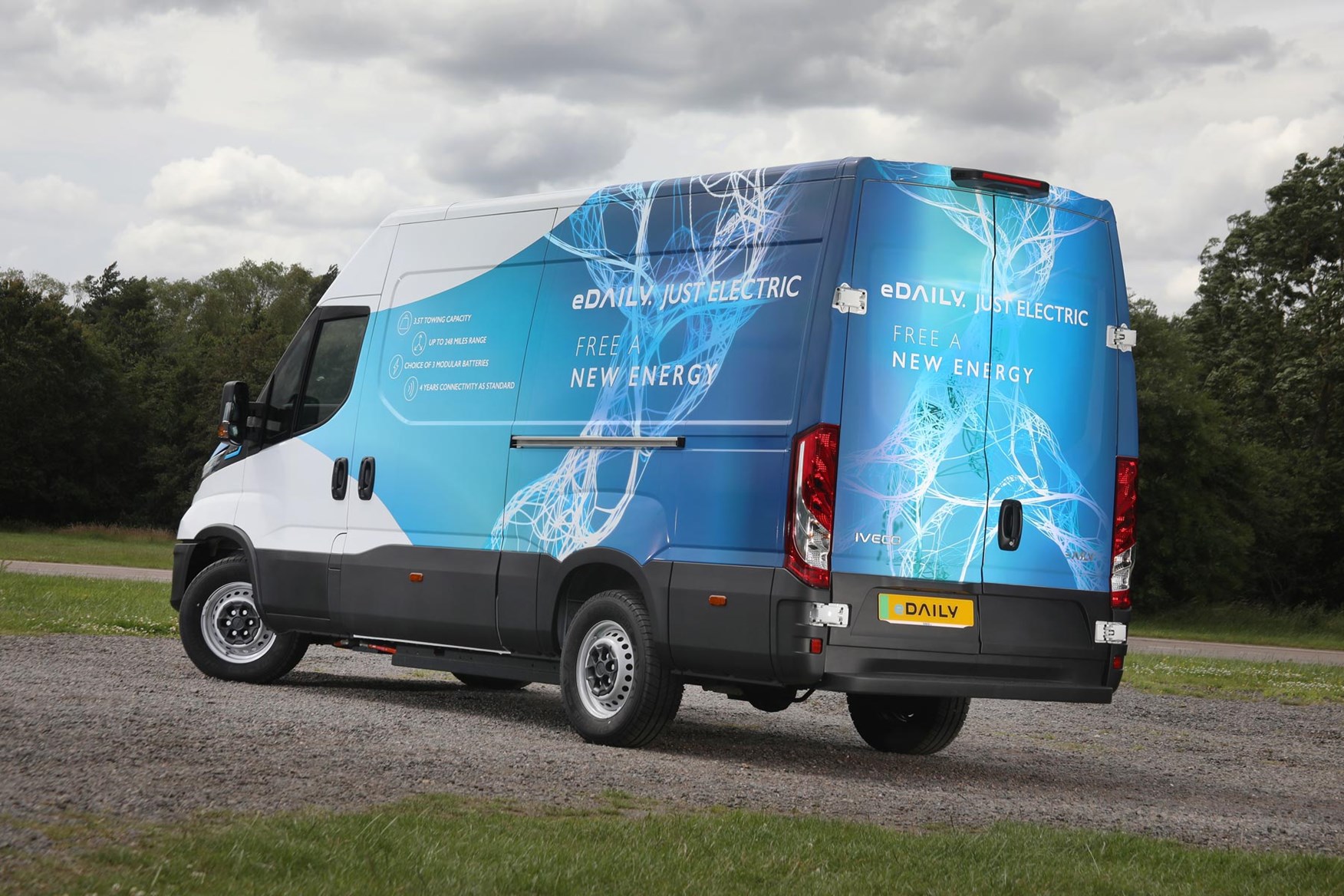
Like almost every electric vehicle on sale, the battery is covered separately. Iveco’s battery warranty lasts eight years, and guarantees 80% of original capacity. This is a higher threshold than most EVs that set the degradation at 70%. However, the mileage limit depends on your configuration. Dual or triple battery models have a limit of 155,000 miles, but the anticipated heavier workload (and extra charge cycles) of the 37kWh single-battery model reduces that to 100,000 miles.
Going forward, it is likely that rolling extended warranties and subscription packages will define the eDaily’s support and maintenance. Iveco anticipate the eDaily being supported for the third or fourth owner, rather than focusing solely on the new and second owners.
It's far too soon to tell if the electric eDaily will be particularly reliable. However, we expect the eDaily match the standard Daily’s reputation, but with the advantage of no combustion-related wear. The strength of the van’s chassis and components is identical, plus drivers get the same connected telematics system which can monitor driving style and even predict failures based on data from a wide fleet of similar vehicles.
The motor and gearbox assembly is very well engineered and designed for straightforward maintenance, and the rear axle is fundamentally the same as a regular Daily, built for the same task. Long service intervals reflect the clean running and robust nature of the eDaily.
- Most models include city braking and lane keeping
- Strong body and chassis inherently safe for driver
- Connected apps monitor locks, safety systems and location
Iveco eDaily safety
As a modular platform, an Iveco eDaily’s safety credentials can be partially dependent on the builder. However, the cargo vans offer a solid armoury of kit for car-like safety abilities. That includes autonomous emergency braking with city safe, plus active lane keeping and cross-wind assist.
These are standard equipment on every eDaily except for the single battery models. Where fitted, the driver assistants work well and contribute to a holistic approach to safety, by reducing driver fatigue in tedious conditions. AirPro suspension offers another layer of safety by optimising load level and ride height and improving handling, but it is quite expensive.
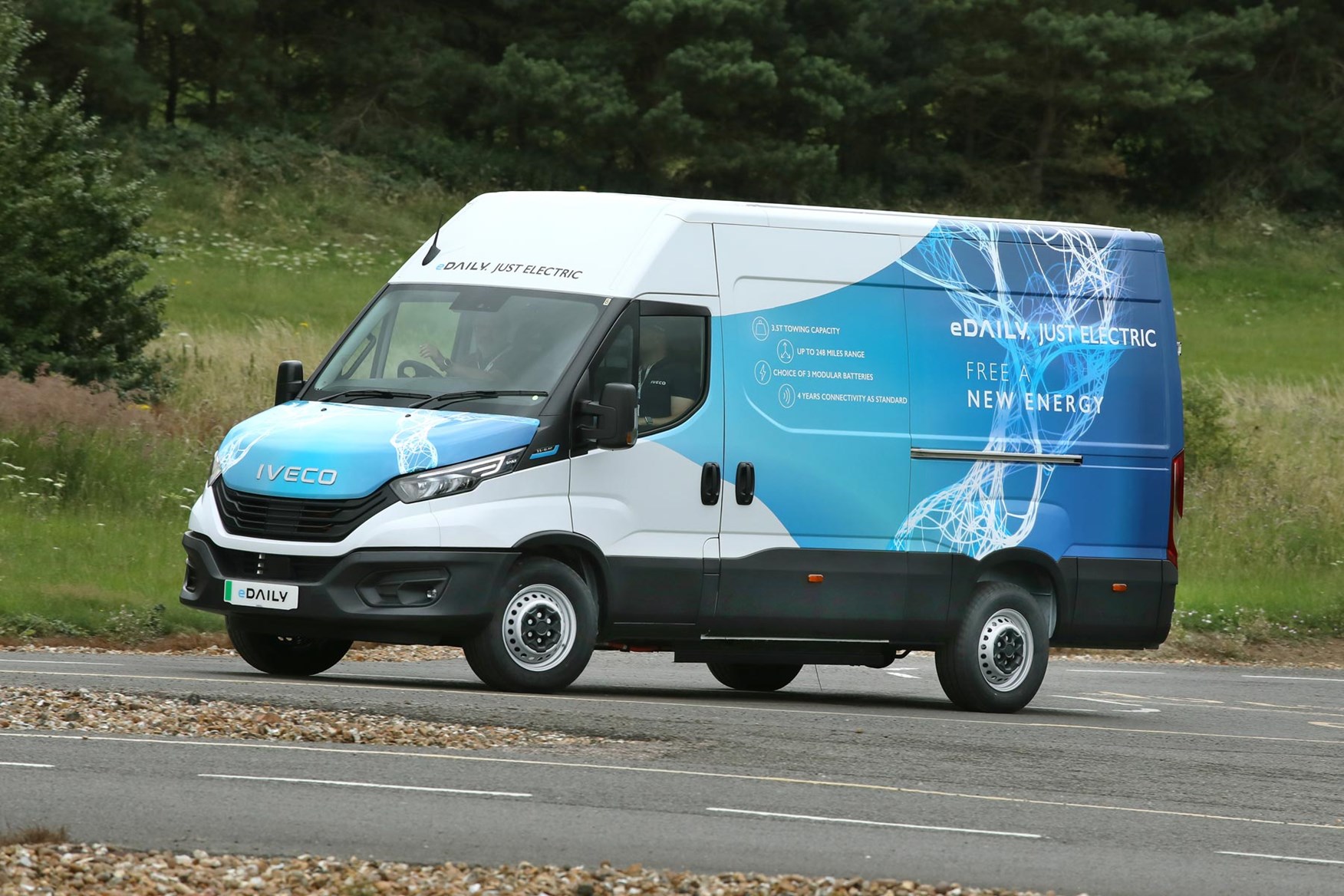
The eDaily’s smooth regenerative braking, easily controlled low-speed performance and disc brakes during high-speed deceleration are also beneficial for safety. The van is also optionally available with an Alexa-based voice assistant which allows emergency contact and driver-sourced live alerts for upcoming hazards.
Fleet options for Iveco eDaily safety
Based on the fleet ownership of the Daily, the eDaily can offer some useful extra safety features. Via the connected telematics, fleet managers can enforce certain safety rules, such as preventing the handbrake from being disengaged until the driver puts their seatbelt on.
The rear reversing camera offers additional protection for workers around the eDaily van. The AirPro suspension also promises to reduce the strain on workers’ bodies, as it can drop the eDaily’s ride height when parked to make it easier to load and unload. This is a benefit not to be overlooked – it’s quite a step down from the load bay to the floor on heavier duty versions.
Which IVECO eDaily is best for me?
It is unlikely that the 37kWh single battery Iveco eDaily is going to meet the needs of many users, despite being the most affordable option. However, for frequent urban routes of short distances and dense payloads it may be sufficient. That 73 mile range and lack of fast charging could prove very limiting in winter, though. Yet the single battery, short van is the only one that can compete on price with the Ford E-Transit.
Iveco eDaily van – worth the premium price?
If you're shopping for a medium to large electric van, the Iveco's comfort and flexibility, as well as its ruggedness, is appealing. But like choosing Leica over Canon for a digital camera, it comes with a price – if you don't need a tool that can survive extreme stresses or last long enough to be an heirloom, the eDaily's £40,000-ish price premium may be tricky to justify.
That's based on the highest payload without venturing into the large goods vehicle category, at 1,598kg. You'll find that in the 4.25t derogation-compatible eDaily, with 74kWh dual battery and 3520 H2 body. That's comparable to a Ford E-Transit 425 L2 H2 – there's less than 10kg between their published specs, though this varies with driver allowance and equipment. The Iveco has slightly more cargo volume, and they're well-matched on power and range, but you'll pay less than £54,000 CV OTR before options for the Ford; the Iveco is over £95,000.
Fleet and leasing deals will vary, but it seems like the eDaily is going to be better suited to bespoke solutions.
Those bespoke solutions could be as simple as 'towing'; at the time of writing the eDaily is the only electric van that can tow 3.5 tonnes.
Where eDaily becomes most competitive is when exploring the options you won’t find anywhere else, such as the 7.2-tonne, large and tall van with 114 kWh battery that offers an easy to live with alternative to a Fuso e-Canter or similar. It also offers three different ePTO solutions for 12V, 400V and mechanically-driven options.
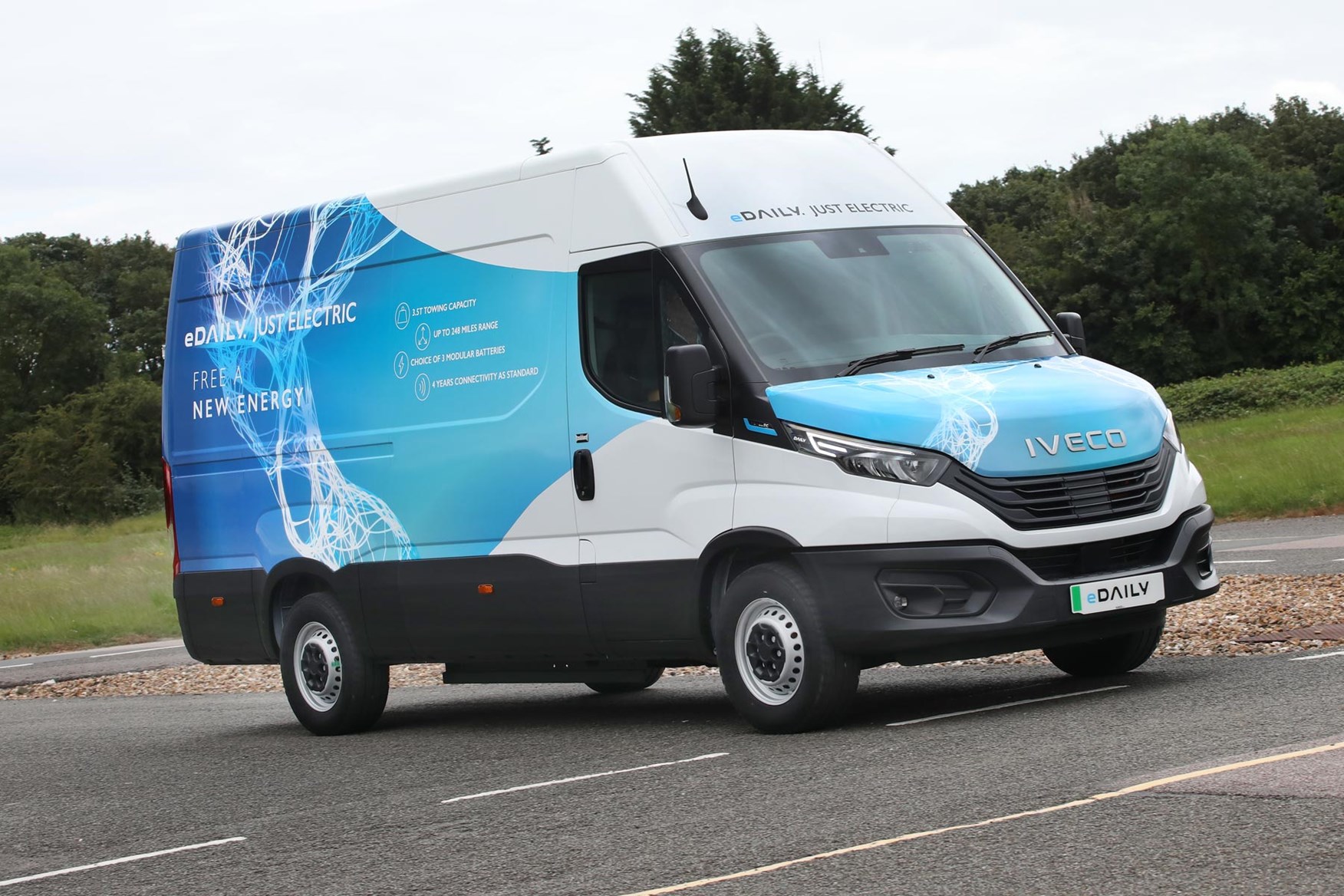
All 74kWh and above models can tow 3.5 tonnes, with significant torque available, so there’s plenty of scope for the eDaily as a service and support vehicle for environmentally friendly enterprises as well.
Finally, as a last-mile solution in a bigger logistics chain, the eDaily equipped with AirPro and / or bespoke load boxes can be tailored to your hub’s layout. Platform compatibility with bays designed for HGVs, but the smaller-footprint of a van for urban delivery, has the potential to save time and money while transitioning to a zero-emission solution for the densest traffic and road networks; exactly the point at which an electric vehicle shines, and diesel emissions are most significant.
Ultimately the eDaily isn’t a vehicle you choose because a particular model covers lots of bases, it’s something you identify all your needs for, then specify it to cover all of them.















